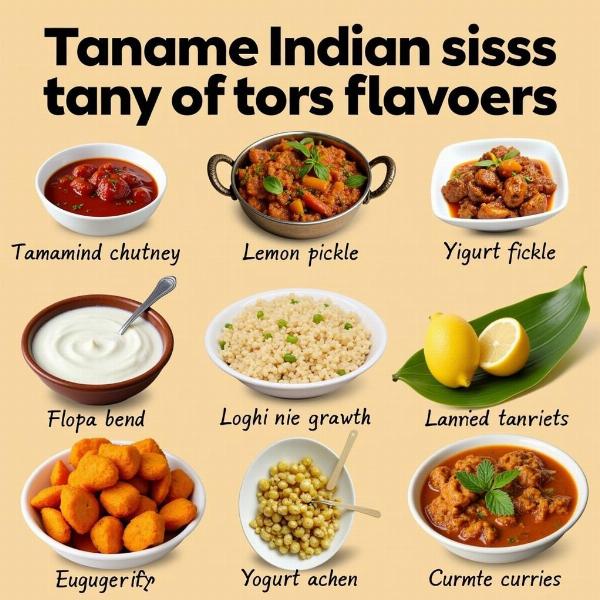Understanding the various meanings of “tang” in Hindi can be tricky, especially given its diverse applications in English. This article aims to clarify the different interpretations of “tang” and provide accurate Hindi translations for each, along with relevant examples. Whether you’re looking for the Hindi equivalent of “tang” in a culinary context, referring to a sharp taste, or exploring its meaning related to tools, this guide will provide valuable insights. Let’s dive in and unravel the “tang meaning in Hindi.”
Decoding the Different Meanings of “Tang”
The word “tang” has a surprising number of meanings in English, making its translation to Hindi context-dependent. Here are some common interpretations:
-
A sharp, pungent, or distinctive flavor: This is perhaps the most common usage of “tang.” In Hindi, we can use words like “तीखा” (teekha – spicy), “कसैला” (kaseela – astringent), “चटपटा” (chatpata – tangy), or “खट्टा” (khatta – sour), depending on the specific nuance of the flavor. For instance, the tang of lemon would be “नींबू का खट्टा स्वाद” (nimbu ka khatta swad).
-
A strong, unpleasant odor: While less frequent, “tang” can also refer to a sharp smell. In this context, words like “तीव्र गंध” (teevra gandh – strong smell), “दुर्गंध” (durgandh – bad smell), or “उग्र गंध” (ugra gandh – pungent smell) might be appropriate.
-
The projecting part of a tool: “Tang” can also describe the part of a tool, like a knife or chisel, that fits into the handle. The Hindi translation for this would be “मूठ में फिट होने वाला हिस्सा” (muth mein fit hone wala hissa – the part that fits into the handle) or more simply, “दस्ता” (dasta – handle).
-
A projecting part of a fruit or vegetable: A similar meaning applies to the part of a fruit or vegetable, like an apple core or orange segment, that connects to the stem or core. This could be translated as “फल या सब्जी का जुड़ा हुआ हिस्सा” (phal ya sabji ka juda hua hissa – the connected part of a fruit or vegetable) or “डंठल” (danthal – stem).
Tang in Culinary Contexts
 Tangy Flavors in Indian Dishes
Tangy Flavors in Indian Dishes
In cooking, “tang” often refers to a desirable, piquant flavor. Think of the tang of yogurt in a raita, or the tang of tamarind in chutney. In these instances, “चटपटा” (chatpata) is an excellent translation, conveying the delightful zing of the flavor. For example, “इस चटनी में एक चटपटा स्वाद है” (is chutney mein ek chatpata swad hai – this chutney has a tangy flavor).
Tang as a Descriptor of Tools
When referring to tools, “tang” has a more technical meaning. Imagine the metal part of a knife blade that extends into the handle. This is the tang, essential for securing the blade. “दस्ता” (dasta) or “मूठ में फिट होने वाला हिस्सा” (muth mein fit hone wala hissa) effectively captures this specific definition. For example, “चाकू का दस्ता टूट गया है” (chaaku ka dasta toot gaya hai – the tang of the knife is broken).
Tang and Its Sensory Perceptions
“Tang” often invokes a sensory experience, be it taste or smell. Understanding the specific sensation is crucial for accurate translation. length and width meaning in hindi Is it a pleasant tang, like the zest of citrus, or an unpleasant one, like a metallic tang? The Hindi translation needs to reflect this distinction. For example, the sharp, unpleasant tang of iron might be described as “लोहे की तीव्र गंध” (lohe ki teevra gandh – the strong smell of iron). hindi meaning of intangible
Conclusion: Context is Key
As we’ve seen, translating “tang” into Hindi requires careful consideration of the context. Whether it’s describing a flavor, a smell, or a part of a tool, choosing the right Hindi word is crucial for conveying the intended meaning. tangent meaning in hindi By understanding the nuances of “tang” and its various applications, you can effectively communicate its meaning in Hindi.
FAQ:
- What is the most common Hindi translation for “tang”? The most common translation depends on the context, but “teekha” (तीखा), “kaseela” (कसैला), “chatpata” (चटपटा), and “khatta” (खट्टा) are frequently used.
- How do you say “the tang of lemon” in Hindi? “नींबू का खट्टा स्वाद” (nimbu ka khatta swad).
- What is the Hindi word for “tang” when referring to a tool? “दस्ता” (dasta) or “मूठ में फिट होने वाला हिस्सा” (muth mein fit hone wala hissa).
- Can “tang” refer to a smell in Hindi? Yes, words like “तीव्र गंध” (teevra gandh) or “दुर्गंध” (durgandh) can be used.
- Is “chatpata” a suitable translation for “tang” in culinary contexts? Often, yes, as it captures the pleasant, piquant aspect of the flavor.
Meaning-Hindi.in offers professional translation services in a variety of specialized fields, including business, legal, technical, website localization, education, and more. We provide accurate and culturally sensitive translations, ensuring your message resonates with your target audience. joda meaning in hindi chakna meaning in hindi Contact us for expert Hindi translation services at [email protected] or call us at +91 11-4502-7584. Meaning-Hindi.in is your trusted partner for bridging language barriers.